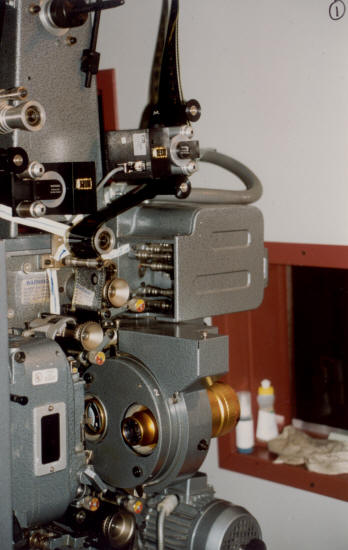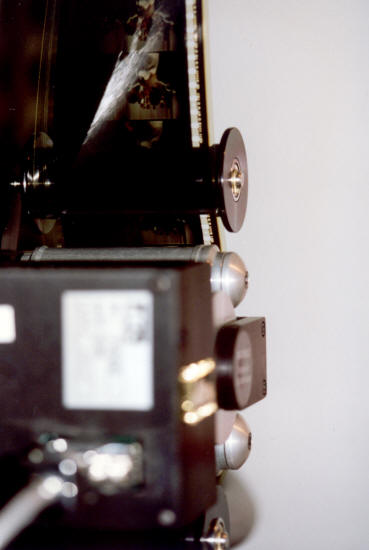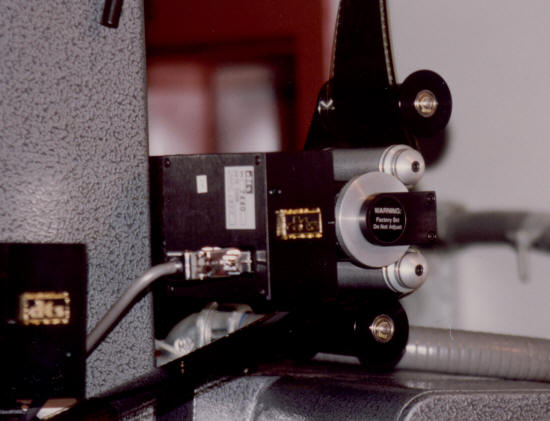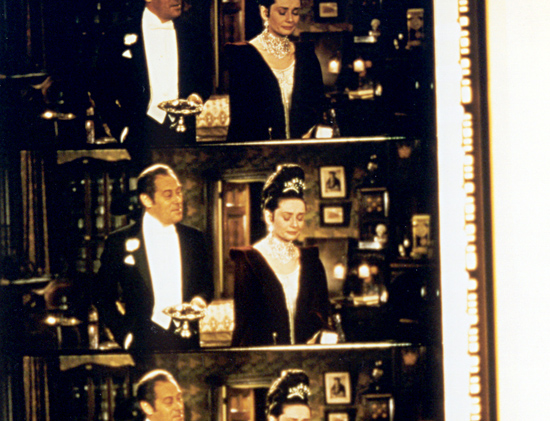"Mulan" in 70mm at the Hollywood Bowl |
This article first appeared in |
| Written and photographed by: Paul Rayton | Issue 53 - June 1998 |
 Cinemeccanica
projector with a 70mm DTS reader. Cinemeccanica
projector with a 70mm DTS reader. The Walt Disney Company had several DTS 70mm prints made of their new animated film "Mulan". We doubt that any further uses of these prints are contemplated, but they were at least being used locally for an invitational premiere on June 5 -- in L.A. at the Hollywood Bowl! The film opened nationwide in the US in 35mm on June 19, 1998. There were at least 3 complete prints, plus countless miscellaneous other reels also printed. However, all the other reels were rejected for various reasons of color, or flickering, or problems with the black masking printed on either side of the image. The film was to run at 1.85:1 ratio, so the plan was to black in the sides. Ultimately, because of the continuing problems with the various labs, the prints were finally produced without the black masking borders! So it was blacked out by aperture plates in the projectors. The initial report about it being made with DTS timecode was only partially correct: only the final reel (reel 5) was made with the timecode, and that was done not for the soundtrack itself, but to use the DTS process to synchronize some fireworks events at the end of the film presentation. This is something like was done with those flashing strobe lights in selected cinemas for the teasers of "The Lost World". There is an add-on device from DTS which takes some reference information off the time code, triggering desired special events at the appropriate moment. So, reel 5 had timecode, the other 4 reels were silent! |
Further in 70mm reading:
|
 Cinemeccanica
projector with a 70mm DTS reader. Cinemeccanica
projector with a 70mm DTS reader. The film sound was supplied by interlocked magnetic tracks on separate machines (using 35mm magnetic film). These were the so-called "6-track" masters, which were also used as the source material for the various analog and digital sound tracks. The reason given for using this equipment- and labor-intensive process was that, because of the size of the Hollywood Bowl, it was necessary to delay the sound by "regions", depending on how far away from the screen the various seats were located. The intent was that everyone in the audience would see and hear the sound in synchronization with the picture. This was accomplished by a digital variable delay which customized the vast Bowl seating areas into distinct audio zones. There was a difference of a full 3 frames from front row to back. The picture was projected on a special screen that came up out of the "floor" of the stage, following a one-hour live stage show featuring Disney characters and music, plus music and performers themed to the film, which takes place in ancient China. The screen was 85ft wide, and 46ft high and it was 205 feet from projector to screen. Lens focal length was 130mm. The size of the screen (plus the problem of nighttime ambient light, making it hard to get the space really dark) were the reason(s) that they felt it necessary to use the 70mm print size. And, in fact, the prints were also made 2 printer points "lighter", to let even more light through to the screen. |
|
 Cinemeccanica
projector with a 70mm DTS reader. Cinemeccanica
projector with a 70mm DTS reader. This washed out (desaturated) the colors slightly. The net result of all this means that, to be realistic, there is virtually no likelihood that the prints could or will ever be subsequently mag striped and used in some theatrical situation. Furthermore, there was a reasonably noticeable flicker in the image, a product of the blow-up process somewhere. However, they ran out of time and were not able to figure out what was causing it, other than "something in the printing process". So, don't look forward to seeing "Mulan" in 70mm at your local cinema! Part of the problem these days is that labs seem to be out of practice in producing good 70mm prints, just like many cinema projectionists are similarly out of practice in handling 70mm prints. |
|
 DTS
time code track on "My Fair Lady" 70mm print. DTS
time code track on "My Fair Lady" 70mm print. These prints, by the way, were not produced from a 65m negative, but rather from a 35m dupe negative. The enlargement process took place individually for each and every reel. Part of the reason for no 65mm negative was that there were only to be "a few" prints made. Of course, in retrospect, maybe that wasn't the right decision, as they must have had to throw away many, MANY rolls of film. "Hundreds", if the Disney sources are not exaggerating! Print rehearsals were done at the Hollywood Galaxy cinema because they couldn't rehearse at the Hollywood Bowl for several reasons, one of which was that it wouldn't get dark enough to see the film until about 8:30 or 9:00pm. They are supposed to finish making "noise" (to not disturb the neighbors in the area) by 11:00pm. That's not much time to rehearse. Other reasons include the Bowl stage being busy setting up the "live" part of the program, and the unavailability of the prints .... |
|
| Go: back
- top - back issues Updated 22-01-25 |
